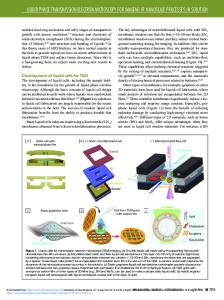Transmission electron microscopy observation of nanoscale deformation structures in nacre
- PDF / 1,076,694 Bytes
- 9 Pages / 612 x 792 pts (letter) Page_size
- 95 Downloads / 335 Views
Yusuke Owaki and Yutaka Kagawa Research Center for Advanced Science and Technology, University of Tokyo, Meguro, Tokyo 153-8904, Japan (Received 18 March 2008; accepted 18 August 2008)
The mechanical performance of nacre in seashells is generally described in terms of mesoscale mechanisms between mineral plates within the organic polymer matrix. However, recent work has reported nanostructures and organic material within individual plates and associated deformation mechanisms. In this work, we further investigated the nanoscale structure and mechanical behavior within individual plates of nacre by using two methods to induce fracture of plates: microindentation with focused ion beam preparation and ultramicrotomy. Using transmission electron microscopy, we observed deformation nanostructures and organic matrix within plates and identified nanoscale mechanisms, such as separation, shear, and matrix crack bridging.
I. INTRODUCTION
Biological materials are well known for their ability to obtain high performance through complex and highly ordered use of composition and structure, and their design principles offer opportunities in the development of new materials.1–3 Nacre, known commonly as “mother of pearl” in seashells, has been studied for many decades because of its excellent mechanical properties. Nacre is effectively a composite material, with polygonal plates of aragonite (a polymorph of CaCO3) within layers of organic polymer matrix. In its natural environment, nacre prevents the shell from breaking catastrophically by absorbing fracture energy during attacks by predators,2,4 with reported work of fracture up to three orders of magnitude greater than pure aragonite, despite being almost 95% aragonite by volume.4 In mechanical testing of bulk nacre samples, failure commonly occurs at the much weaker organic matrix and individual plates are left intact.5 Hence, plates of aragonite have commonly been treated as single crystals in analyses and modeling, with toughening mechanisms attributed to interactions between whole plates and the matrix, such as plate sliding and pullout, friction between rough plate surfaces, interlocking of irregular plates, crack deflection and blunting, and matrix crack bridging.2–12 Nanoscale structures
a)
Address all correspondence to this author. e-mail: [email protected] DOI: 10.1557/JMR.2008.0389 J. Mater. Res., Vol. 23, No. 12, Dec 2008
http://journals.cambridge.org
Downloaded: 26 Sep 2015
within individual plates had been reported in the 1960s, with transmission electron microscopy (TEM) observation of “blocks” of aragonite surrounded by “intracrystalline” matrix13,14; and in the 1970s, with scanning electron microscopy (SEM) observation of “crystalline elements” within organic “membranes”.15 More recently, observation of aragonite nanoparticles (called “nanograins”) surrounded by organic material in individual nacre plates have been reported using methods such as SEM, atomic force microscopy (AFM), and TEM.16–23 Figure 1 illustrates the multiscale construction of sea
Data Loading...











